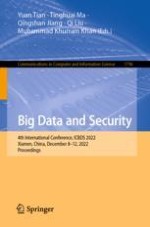2023 | Buch
Big Data and Security
4th International Conference, ICBDS 2022, Xiamen, China, December 8–12, 2022, Proceedings
herausgegeben von: Yuan Tian, Tinghuai Ma, Qingshan Jiang, Qi Liu, Muhammad Khurram Khan
Verlag: Springer Nature Singapore
Buchreihe : Communications in Computer and Information Science
